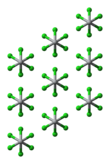Titanium(III) chloride

| |||
| |||
| Names | |||
|---|---|---|---|
| Other names
titanium trichloride
titanous chloride | |||
| Identifiers | |||
3D model (
JSmol ) |
|||
| ChemSpider | |||
ECHA InfoCard
|
100.028.845 | ||
| EC Number |
| ||
PubChem CID
|
|||
RTECS number
|
| ||
| UNII | |||
CompTox Dashboard (EPA)
|
|||
| |||
| |||
| Properties | |||
| TiCl3 | |||
| Molar mass | 154.225 g/mol | ||
| Appearance | red-violet crystals hygroscopic
| ||
| Density | 2.64 g/cm3[1] | ||
| Melting point | 440 °C (824 °F; 713 K) (decomposes)[1] | ||
| very soluble | |||
| Solubility | soluble in acetone, acetonitrile, certain amines; insoluble in ether and hydrocarbons | ||
| +1110.0×10−6 cm3/mol | |||
Refractive index (nD)
|
1.4856 | ||
| Hazards | |||
| Occupational safety and health (OHS/OSH): | |||
Main hazards
|
Corrosive | ||
| Safety data sheet (SDS) | External MSDS | ||
| Related compounds | |||
Other anions
|
Titanium(III) fluoride Titanium(III) bromide Titanium(III) iodide | ||
Other cations
|
|||
Related compounds
|
Titanium(IV) chloride
Titanium(II) chloride | ||
Except where otherwise noted, data are given for materials in their standard state (at 25 °C [77 °F], 100 kPa).
| |||
Titanium(III) chloride is the inorganic compound with the formula TiCl3. At least four distinct species have this formula; additionally hydrated derivatives are known. TiCl3 is one of the most common halides of titanium and is an important catalyst for the manufacture of polyolefins.
Structure and bonding
In TiCl3, each titanium atom has one d electron, rendering its derivatives
Four solid forms or
Two hydrates of titanium(III) chloride are known, i.e. complexes containing
Synthesis and reactivity
TiCl3 is produced usually by reduction of
- 2 TiCl4 + H2 → 2 HCl + 2 TiCl3
It can also be produced by the reaction of titanium metal and hydrochloric acid.
It is conveniently reduced with
- TiCl3 + 3 C4H8O → TiCl3(OC4H8)3
An analogous dark green complex arises from complexation with dimethylamine. In a reaction where all ligands are exchanged, TiCl3 is a precursor to the blue-colored complex Ti(acac)3.[8]
The more reduced titanium(II) chloride is prepared by the thermal disproportionation of TiCl3 at 500 °C. The reaction is driven by the loss of volatile TiCl4:[9]
- 2 TiCl3 → TiCl2 + TiCl4
The ternary halides, such as A3TiCl6, have structures that depend on the cation (A+) added.[10] Caesium chloride treated with titanium(II) chloride and hexachlorobenzene produces crystalline CsTi2Cl7. In these structures Ti3+ exhibits octahedral coordination geometry.[11]
Applications
TiCl3 is the main Ziegler–Natta catalyst, responsible for most industrial production of polyethylene. The catalytic activities depend strongly on the polymorph of the TiCl3 (α vs. β vs. γ vs. δ) and the method of preparation.[12]
Laboratory use
TiCl3 is also a specialized reagent in organic synthesis, useful for reductive coupling reactions, often in the presence of added reducing agents such as zinc. It reduces oximes to imines.[13] Titanium trichloride can reduce nitrate to ammonium ion thereby allowing for the sequential analysis of nitrate and ammonia.[14] Slow deterioration occurs in air-exposed titanium trichloride, often resulting in erratic results, such as in reductive coupling reactions.[15]
Safety
TiCl3 and most of its complexes are typically handled under
References
- ^ OCLC 29029713.
- ISBN 978-0-08-037941-8.
- ISBN 978-0-08-037941-8.
- ISBN 978-0-470-13237-1.
- .
- .
- ISBN 978-0-471-86520-9.
- S2CID 99668641.
- ISBN 0-12-352651-5.[page needed]
- .
- .
- ISBN 978-3527306732.
- ISBN 978-0-471-93623-7.
- ^ Rich, D. W.; Grigg, B.; Snyder, G. H. (2006). "Determining Ammonium & Nitrate ions using a Gas Sensing Ammonia Electrode". Soil and Crop Science Society of Florida. 65.
- .
- ISSN 0008-4042.
- ISBN 978-0-470-52330-8.


